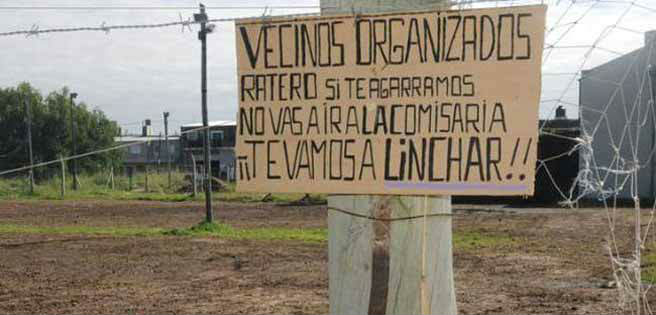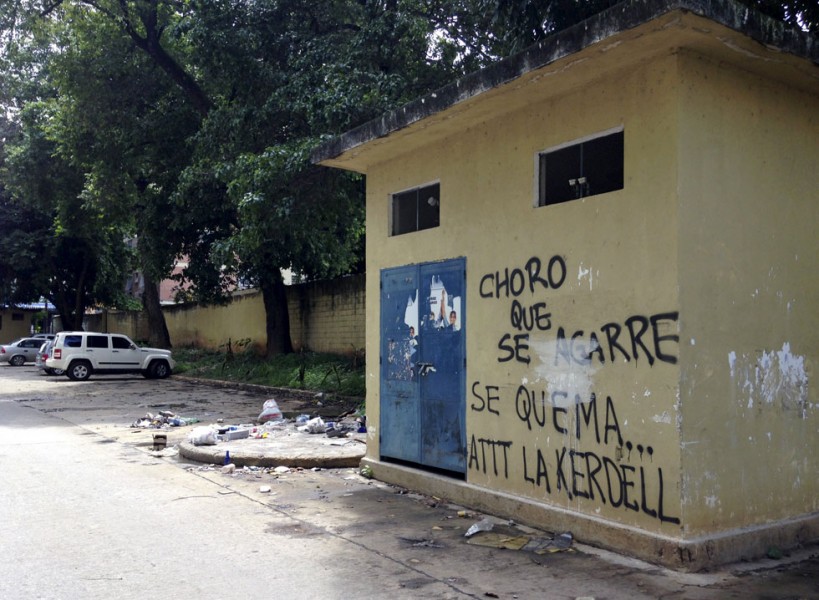A Lynching Outside My Window
As lynchings become commonplace in Venezuela, some let the violence creep in, while some just turn up the TV.



In the last two years I’ve seen colectivos and National Guardsmen beat protesters, I’ve seen a sicario execute a man at a party, I’ve seen policemen shoot at thieves as they run away, miss and hit a neighbor, I’ve been woken up at night by shots and shouts ringing out in the dark. The city resembles a battlefield.
But six months ago, a new step up the ladder of horror was reached when I heard screaming yells of “¡Agárralo! ¡Agárralo!” – Grab him! Grab him!
It must have been about three in the afternoon, the sun reflected on Plaza Altamira and a crowd appeared on the avenue on the other side. A circle of people screaming and kicking towered over what seemed to be a man, a suspected assailant. Luckily (I say luckily, some will disagree) the police arrived to grab the man from the clutches of the mob.
Our tribal, mob-like capacity for organization is surprising.
Lynchings have now become commonplace. Our level of barbarism just scaled up a notch. According to the Provea report on Human Rights, from 2001 to 2011, from 6 to 25 lynchings had occurred in Venezuela each year. But in 2015 a new high was reached in our terrible streak of horror records. From January to October, 38 lynchings were reported, 13 of the from August to October. Tal Cual reported last week that 29 attempted lynchings have occurred so far in 2016, with 5 of them resulting in death. After a man was beat and burned to death in Los Ruices, newpapers reported that he had not committed the crime the mob lynched him for.
Lynchings have doubled and are a symptom of loss of civility, but they have also become more complex. Their new found visibility comes from the fact that they have migrated from the poorer communities to middle and upper class neighborhoods.
I’m intrigued not only about the meaning of this increase but also by the reactions our society has to them. A post by Rodrigo Linares here on Caracas Chronicles describes how lynchings are filmed and then shared on social media. I’m shocked not just that people, in their vulnerability, react by taking justice into their own hands, but also by the heartfelt celebration these episodes set off. Our tribal, mob-like capacity for organization is surprising. For a society that tends to have difficulties with teamwork, this is quite a phenomenon.
It’s been reported that neighbors in at least two middle class neighborhoods have organized themselves with whistles and networks to signal the occurrence of robberies and coordinate responses.
A report in Efecto Cocuyo describes how in Lomas del Ávila, neighbors use whistles to set off a collective alarm that has led to lynchings. Something similar seems to have happened in Los Ruices. As a neighbor told journalists:
“The press doesn’t register all of them, but we’ve grown used to them. In my case, every time I hear shouts saying ‘grab them!’ I turn up the volume of my TV so I don’t hear too much. At first it scared me. But not anymore. I don’t even look out my window to see what happened”.

Of course, I’m not alone in seeing horror outside my window. But that’s a simple matter of fact. The more worrying aspect is subjective: some of us, like the woman in the interview who can’t think of a better way to respond than turn the volume of her TV up so she doesn’t have to hear too much.
Lynchings have installed themselves in our fantasyscape. National surveys show that large majorities condone them as a response to certain types of crimes, such as rape. They’ve become part of our cultural repertoire.
In 2012 the rock group Famasloop put out a fascinating video of their song “The Choro Dance”. We see the lead singer kidnapped by what turns out to be a muppet that imposes his “dance” through violence and intimidation. It is funny and disturbing at the same time. In the end, redemption is gained by an armed Christ who, along with a mob, grabs the muppet and burns him alive in all his plushness.
Ignacio Martín-Baró was a social psychologist who studied the effects of the civil war of El Salvador on the country’s way of life. He described a “militarization of the mind” derived from a chronic state of violence, one that produces a simplistic logic when trying to understand and solve social problems, one where violence becomes the privileged way of dealing with conflict.
A large part of the of bestselling venezuelan Hector Torres’ literature is based on the sights he has looking out his window of his Avenida Baralt apartment, right in downtown Caracas.
At first glance his books “Caracas Muerde” and “Objetos No Declarados” might seem a simple inventory of our varied forms of hobbessian city life. I beg to differ. Hector goes beyond a pulp fiction Caracas, he does the opposite of the Los Ruices neighbor and turns the volume up on the events outside his window, not to shock but to explore the many subtle ways that violence creeps into our way of living, thinking, feeling.
He writes:
You get to thinking about kids in whose homes all they talk about is crime, about how expensive everything is, about the life sentence involved in being poor, and you see them going out of their homes each morning in places that are dimly lit and absolutely given over to crime, and you can’t help but ask yourself: what do these children think of themselves? What sense of hope can they have? Can they be expected to believe there’s room for them in the future?…what else can they possibly express, with what language, if not with the same language the city uses to speak to them?
I think these are some of our most urgent unanswered questions.
Caracas Chronicles is 100% reader-supported.
We’ve been able to hang on for 22 years in one of the craziest media landscapes in the world. We’ve seen different media outlets in Venezuela (and abroad) closing shop, something we’re looking to avoid at all costs. Your collaboration goes a long way in helping us weather the storm.
Donate




